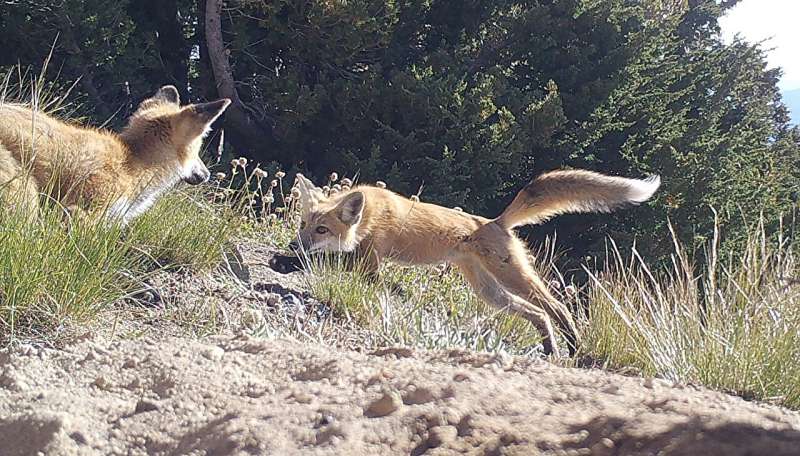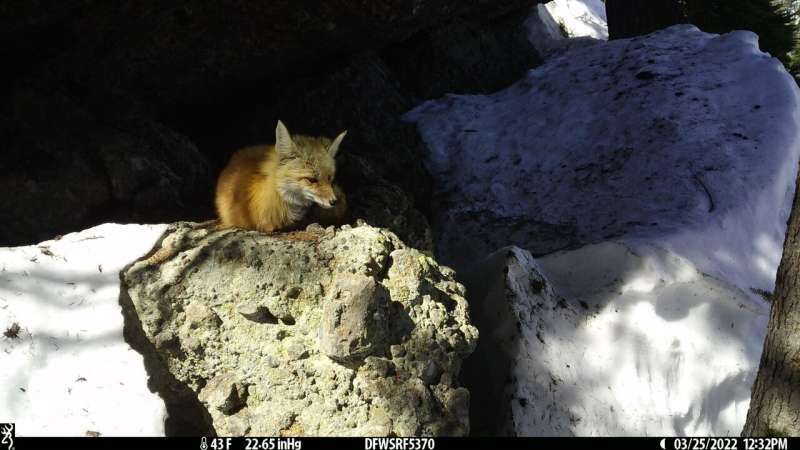
Two Lassen red fox puppies playing together. Credit: California Department of Fish and Wildlife
Rescue efforts can take many forms—life rafts, fire engines, airplanes. For animals whose numbers are reduced by reproduction, the gene itself can save lives.
Genomic research led by the University of California, Davis, reveals clues about the ancient history of montane red foxes that may be important for their future survival. The study, published in the journal Molecular Biology and Evolutionis investigating the potential of genetic rescue to help restore the population of red foxes living in the mountains. The research is especially important for the 30 or fewer red foxes that live in the Lassen Peak region of California.
The study found that reproduction affects the Lassen red fox population. Thousands of years ago – long before uncontrolled trapping and poisoning drove people back in the 1890s and early 1900s – red foxes were not confined to these mountains, they mingled with neighboring foxes in Oregon, Rocky Mountains and Washington Cascades more. they are today. This makes them well positioned for genetic rescue should managers decide to pursue it and integrate the population.
“There was nothing we found that prevented the red fox from delivering the gene,” said lead author Cate Quinn, who conducted the study as a UC Davis postdoctoral researcher in Mammalian Ecology and Conservation. Unit in the School of Veterinary Medicine. He is currently an entomologist at the USDA Forest Service Rocky Mountain Research Station. “Study shows genetic rescue may be a good option for Lassens.”
Rescue workers
Genetic rescue is a conservation tool to reverse the effects of reproductive depression, which is when childbirth reduces the body’s physical fitness and fertility. Genetic rescue involves bringing new people into society to introduce genetic changes and promote growth.
The tool is not viewed as a small thing, managers must first understand the seriousness of inbreeding, the rescue of historical genes that need to be restored, and the deep evolutionary relationship that foxes share. each other.
To fill in those knowledge gaps, the scientists assembled 28 whole genomes from four species of montane red foxes. These include small, isolated ones in the Pacific Northwest, Oregon Cascades, Lassen Cascades and Sierra Nevada, as well as large numbers in the Rocky Mountains and areas in the Sacramento Valley. Using genomic technology, authors can look back in time to see if populations have always been isolated, to what extent, and when that began to change.

A red-tailed deer rests near Lassen Peak in this 2022 trail camera photo. Inbreeding affects the Lassen red fox, which was abundant in the area before the 1900s, a UC Davis study found. Credit: California Department of Fish and Wildlife
Value, combined and different
The study found that recent high levels of productivity in the Lassen and Sierra Nevada red fox populations, and that Lassen red foxes are an important factor for intervention. Only one montane red fox is known to have entered the Lassen in more than 20 years of monitoring, the study said.
This data also shows that 10,000 to 12,000 years ago, montane red foxes in the Western United States were large, linked to different genes. Lassen’s population likely interbred with Oregon red foxes over the past century, breaking out from each other recently, Quinn said.
A path of hope ahead
Taken together, these findings point to a hopeful path forward for the Lassen red fox, and for other red foxes facing similar challenges.
“We think trapping caused their numbers to drop, but we don’t know what’s keeping them so small,” said lead author Ben Sacks, director of the Department of Mammal Conservation and Ecology at the UC Davis School of Veterinary Medicine. “Now we see that what made them smaller seems to be causing the depression. If the reason for their decline is gone, can we bring them back? There is hope here.”
Quinn agreed, “Not too long ago, this was a large, integrated, diverse population. The diversity is still there. If we were to bring them back as a group, These foxes can still make a difference.”
He warns, however, that true genetic “salvation” seeks to integrate all values—not just increase one population.
“If we consider each pocket individually, they are in trouble, but if we look at the entire montane system, recovery is still possible,” Quinn said.
Other co-authors include Sophie Preckler-Quisquater of UC Davis and Michael Buchalski of the California Department of Fish and Wildlife.
Other information:
Cate B Quinn et al, Whole Genomes Inform Gene Recovery Strategies for Montane Red Foxes in North America, Molecular Biology and Evolution (2024). DOI: 10.1093/molbev/msae193
References: Genetic rescue for the rare red fox? Research reveals options to restore Lassen red fox population (2024, September 26) Retrieved 29 September 2024 from https://phys.org/news/2024-09-genetic-rare-red-foxes-uncovers.html
This document is subject to copyright. Except for any legitimate practice for study or personal research purposes, no part may be reproduced without written permission. This content is provided for informational purposes only.
#Genetic #rescue #rare #red #fox #Research #reveals #options #restore #Lassens #red #fox #population